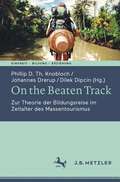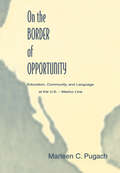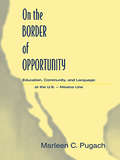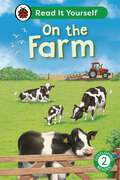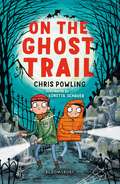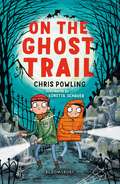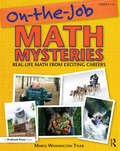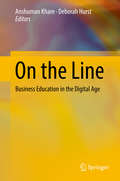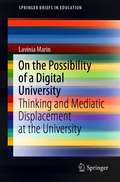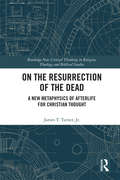- Table View
- List View
On the Beaten Track: Zur Theorie der Bildungsreise im Zeitalter des Massentourismus (Kindheit – Bildung – Erziehung. Philosophische Perspektiven)
by Johannes Drerup Phillip D. Th. Knobloch Dilek DipcinWir leben in einer Welt der ausgetretenen Pfade. Es gibt kaum ein Ort auf diesem Planeten – vom Mount Everest Base Camp bis zur Antarktis –, der nicht in ein Objekt und Produkt möglicher touristischer Erfahrung transformiert wurde oder wird. In der globalen Praxis und im weltumspannenden sozioökonomischen System des modernen Massentourismus spiegeln sich wie in einem Brennglas die Ambivalenzen, Paradoxien und Widersprüche (post-)moderner Formen der individuellen und kollektiven Lebensführung und Selbstverständigung. Dies gilt auch für die in diesem Band diskutierten Zusammenhänge zwischen Reisen und Bildung, die nicht zu trennen sind von Formen der sozialer Distinktion und Ungleichheit, von Hierarchisierungen und Ranglisten und von Macht und Politik.
On the Border of Opportunity: Education, Community, and Language at the U.s.-mexico Line (Sociocultural, Political, and Historical Studies in Education)
by Marleen C. PugachIn 1993, the author set out to try and gain some understanding about school and community in Havens, New Mexico--a place where she had the opportunity to be immersed in border culture, where she could learn how the border figured into everyday life, and where she could pay uninterrupted attention to the issues as they occurred in the personal and professional lives of those who taught in and administered the schools--and in the lives of the students who studied there. This book offers an interpretation that is disciplined by the long hours, days, and months spent in Havens, and by the personal stance the author brings to the study of a place and its people. This book tells the story of Havens from the perspective of what it is, of the present in all of its complexity, and as a window on what might exist in the future in this border community. It begins with a description of Havens and its inevitable interdependence with its Mexican neighbors, followed by an introduction of three "cultural mediators"--two students and one teacher from Havens High School. Focusing on the relationship between the use of Spanish and English, the language landscape in the community and in the schools is laid out. This is followed by a specific description of the development of bilingual education programs in the district, and an introduction of the social structure of the high school, describing the students' interactions across cultural lines. The final chapter presents an alternative metaphor for thinking about the border and identifies markers of opportunity that already exist in Havens as it works toward defining what it means to be a bicultural and binational community.
On the Border of Opportunity: Education, Community, and Language at the U.s.-mexico Line (Sociocultural, Political, and Historical Studies in Education)
by Marleen C. PugachIn 1993, the author set out to try and gain some understanding about school and community in Havens, New Mexico--a place where she had the opportunity to be immersed in border culture, where she could learn how the border figured into everyday life, and where she could pay uninterrupted attention to the issues as they occurred in the personal and professional lives of those who taught in and administered the schools--and in the lives of the students who studied there. This book offers an interpretation that is disciplined by the long hours, days, and months spent in Havens, and by the personal stance the author brings to the study of a place and its people. This book tells the story of Havens from the perspective of what it is, of the present in all of its complexity, and as a window on what might exist in the future in this border community. It begins with a description of Havens and its inevitable interdependence with its Mexican neighbors, followed by an introduction of three "cultural mediators"--two students and one teacher from Havens High School. Focusing on the relationship between the use of Spanish and English, the language landscape in the community and in the schools is laid out. This is followed by a specific description of the development of bilingual education programs in the district, and an introduction of the social structure of the high school, describing the students' interactions across cultural lines. The final chapter presents an alternative metaphor for thinking about the border and identifies markers of opportunity that already exist in Havens as it works toward defining what it means to be a bicultural and binational community.
On the Edge: (Auto)biography and Pedagogical Theories on Religious Education
by Ina Ter AvestFor the first time, leading scholars in Religious Education and Citizenship Education reflect upon ‘the making of’ of their theoretical framework, in honour of Siebren Miedema. In this Liber Amicorum, in retrospect these scholars recognize, implicitly or more explicitly, ‘critical incidents’ and they honour ‘critical persons’ for the decisive voice each of them had in the articulation of the theoretical frame of reference the scholars developed in the field of pedagogy of religion(s) and citizenship education. Or, to use the words Siebren Miedema prefers, the field of religious citizenship education. The ‘eminence grise’ in the field of Pedagogy is brought together in this volume, like John Hull, Bob Jackson and Wolfram Weisse; scholars from the United States of America like Jack Seymour and Mary Elizabeth Moore; scholars from Latin America like Günther Dietz; scholars from the Netherlands like Cok Bakker, Chris Hermans, Henk Kuindersma, Alma Lanser, Wilna Meijer, Bram de Muynck and Doret de Ruyter; scholars from Western Europe like Hans-Günther Heimbrock and Friedrich Schweitzer; scholars from Eastern Europe like Fedor Kozyrev; scholars from up North like Geir Skeie; scholars from down South like Cornelia Roux and Marian De Souza. They all responded to the question of the editor, Ina ter Avest, to reflect upon the relationship between their biography and their developed theoretical framework. For everybody interested in the field of religious citizenship education, this volume offers a thorough introduction to their theories. We hope this comprehensive book will provoke readers to balance on the edge of different perspectives and to stimulate the development of their own line of thought on religious citizenship education.
On the Facilitation of the Academy
by Elias Westergaard Joachim S. Wiewiura"The ‘academy’ is not restricted to the architectural limits of the university, but a broader conception of education that, through its social dissemination, ought to be continually shaped in relation to academic practice, thinking and living. Educational institutions are not solely modern providers of a pertinent workforce but foremost communities of thought with cultural, political and social importance. On the Facilitation of the Academy is thus concerned with educational issues that cohere, but also quarrels with, the university institution today as the highest institutionalised place for learning. The contributors in this volume consider practices of learning, teaching and knowledge acquisition in academic environments. It challenges educational issues in relation to conversation, discourse and tradition as well as contains contributions on threshold concepts, knowledge production and dangerous thinking. Belonging to a variety of academic orientations – philosophy, educational theory, psychoanalysis, communication studies – the authors in this volume offer different takes, but share similar features and aspects, on the worries that should occupy academe today."
On the Farm: Read It Yourself - Level 2 Developing Reader (Read It Yourself)
by LadybirdThere is so much to do on a farm all year round! Join the busy farmers and learn fun facts along the way as they harvest vegetables, grow crops, look after animals and more.On the Farm is from Developing Reader Level 2 and is ideal for readers aged from 5+ who can read short, simple sentences with help.Each book has been carefully checked by educational and subject consultants and includes comprehension puzzles, book band information, and tips for helping children with their reading.With five levels to take children from first phonics to fluent reading and a wide range of different stories and topics for every interest, Read It Yourself helps children build their confidence and begin reading for pleasure.
On the Fast Track: Understanding The Opportunities And Challenges Of Dual Credit, Aehe 42:3 (J-B ASHE Higher Education Report Series (AEHE))
by Barbara F. Tobolowsky Taryn Ozuna AllenThe dual-credit curricular initiative offers high school students the opportunity to earn college and high school credits simultaneously without taking a standardized test to acquire the credit. The courses are purported to introduce students to a more rigorous curriculum in high school and save them time and money in their pursuit of college degrees. Dual credit programs have grown rapidly, and this monograph provides a synthesis of: • the scholarly literature on dual credit offered at high school and a variety of postsecondary settings; • underrepresented students’ experiences with the course(s), and • suggestions for future research and drivers that will influence its development. Originally, these initiatives focused on high-achieving students, but additional models have emerged that expand the benefits to lower- and middle-achieving students as well. This is the third issue of the 42nd volume of the Jossey-Bass series ASHE Higher Education Report. Each monograph is the definitive analysis of a tough higher education issue, based on thorough research of pertinent literature and institutional experiences. Topics are identified by a national survey. Noted practitioners and scholars are then commissioned to write the reports, with experts providing critical reviews of each manuscript before publication.
On the Fast Track: Understanding The Opportunities And Challenges Of Dual Credit, Aehe 42:3 (J-B ASHE Higher Education Report Series (AEHE))
by Barbara F. Tobolowsky Taryn Ozuna AllenThe dual-credit curricular initiative offers high school students the opportunity to earn college and high school credits simultaneously without taking a standardized test to acquire the credit. The courses are purported to introduce students to a more rigorous curriculum in high school and save them time and money in their pursuit of college degrees. Dual credit programs have grown rapidly, and this monograph provides a synthesis of: • the scholarly literature on dual credit offered at high school and a variety of postsecondary settings; • underrepresented students’ experiences with the course(s), and • suggestions for future research and drivers that will influence its development. Originally, these initiatives focused on high-achieving students, but additional models have emerged that expand the benefits to lower- and middle-achieving students as well. This is the third issue of the 42nd volume of the Jossey-Bass series ASHE Higher Education Report. Each monograph is the definitive analysis of a tough higher education issue, based on thorough research of pertinent literature and institutional experiences. Topics are identified by a national survey. Noted practitioners and scholars are then commissioned to write the reports, with experts providing critical reviews of each manuscript before publication.
On the Fractal Language of Medicine (Fractional Order Thinking in Exploring the Frontiers of STEM)
by Bruce J. West W. Alan MutchOn the Fractal Language of Medicine bridges a very clear gap among the knowledge gained over the last 20 years in the physical and life sciences on network theory, organ synchronicity and communication, the understanding of fractal signatures in health and disease and the importance of fractional calculus in integrating these concepts.The authors opine that the field of medicine has not appreciated this hard-won knowledge and has suffered greatly as a result. This book addresses this perceived deficiency by introducing medical researchers, clinicians, residents, first-year medical students and members of allied fields to the work of the so-called hard sciences. It seeks to facilitate effective communication between empiricists and theorists by making interdisciplinary efforts to explain complex mathematical concepts to physicians and, equally important, to elucidate complex medical concepts to physicists or mathematicians.This book will be of great interest to medical students, professionals and academics, as well as students and researchers of applied mathematics, especially those interested in fractional calculus and fractals.
On the Fractal Language of Medicine (Fractional Order Thinking in Exploring the Frontiers of STEM)
by Bruce J. West W. Alan MutchOn the Fractal Language of Medicine bridges a very clear gap among the knowledge gained over the last 20 years in the physical and life sciences on network theory, organ synchronicity and communication, the understanding of fractal signatures in health and disease and the importance of fractional calculus in integrating these concepts.The authors opine that the field of medicine has not appreciated this hard-won knowledge and has suffered greatly as a result. This book addresses this perceived deficiency by introducing medical researchers, clinicians, residents, first-year medical students and members of allied fields to the work of the so-called hard sciences. It seeks to facilitate effective communication between empiricists and theorists by making interdisciplinary efforts to explain complex mathematical concepts to physicians and, equally important, to elucidate complex medical concepts to physicists or mathematicians.This book will be of great interest to medical students, professionals and academics, as well as students and researchers of applied mathematics, especially those interested in fractional calculus and fractals.
On the Fringes: Preventing exclusion in schools through inclusive, child-centred, needs-based practice
by Jackie WardIn On the Fringes: Preventing exclusion in schools through inclusive, child-centred, needs-based practice, Jackie Ward opens up the debate surrounding school exclusion and its link to special educational needs (SEN), and shares action-oriented strategies designed to bring about a more inclusive approach.Too many of our vulnerable young people are being excluded – even those with SEN and the very young who are only just on the cusp of school life. And having seen first-hand the impact that exclusion has on children with often unmet medical needs – such as autistic spectrum condition (ASC) and attention deficit hyperactivity disorder (ADHD) – Jackie explores in this book the realities of what exclusion means to each of us and its impact on wider society.Jackie examines this critical issue through the lens of her experiences in both mainstream and specialist settings and presents practical, solution-focused guidance to help schools deliver the inclusive education that every child deserves. Drawing upon a range of sources, Jackie’s wide-reaching analysis is backed up with case studies, up-to-date research and anecdotal reports – setting out a balanced view focusing on the stated and underlying needs of schools, staff, parents, children and other agencies.On the Fringes scrutinises exclusion procedures and reviews the SEND Code of Practice in depth, particularly highlighting the role of early interventions in detecting underlying SEN and medical needs. Jackie also explores a range of pre-emptive and alternative approaches that can be employed as part of a whole-school approach to pastoral care and behaviour management that develops pupils’ self-awareness and self-regulation.In doing so she offers informed inspiration to teachers and SEN practitioners working with some of our most vulnerable children – who, without our care, compassion and tailored provision, are too often destined for lives on the fringes of society.Suitable for teachers, school leaders, SEN professionals, policy-makers and parents.Chapters include: Chapter 1 – Exclusion facts and figures; Chapter 2 – The legalities of exclusion; Chapter 3 – The school’s view: inclusion versus exclusion; Chapter 4 – A view from the PRU: after the exclusion; Chapter 5 – The child: ‘that kid’; Chapter 6 – The parents’ view; Chapter 7 – Behaviour or complex need?; Chapter 8 – Spotting the signs of underlying needs; Chapter 9 – Addressing mental health and wellbeing; Chapter 10 – Holistic approaches.
On the Ghost Trail: A Bloomsbury Reader (Bloomsbury Readers)
by Chris PowlingA spooky comedy from Chris Powling with hilarious illustrations by Loretta Schauer. Perfect for fans of Amelia Fang and Knitbone Pepper.A ghost has been haunting Ben's grandpa's house with cobweb trails and the TAP-TAP-TAP of its heartbeat. So when the clock strikes twelve, Ben's brother dares him to go on a hunt for the ghost in the church graveyard. Will he be brave enough? This quirky story from Chris Powling has engaging black-and-white illustrations by Loretta Schauer and is perfect for children who are developing as readers. The Bloomsbury Readers series is packed with brilliant books to get children reading independently in Key Stage 2, with book-banded stories by award-winning authors like double Carnegie Medal winner Geraldine McCaughrean and Waterstones Prize winner Patrice Lawrence covering a wide range of genres and topics. With charming illustrations and online guided reading notes written by the Centre for Literacy in Primary Education (CLPE), this series is ideal for reading both in the classroom and at home. For more information visit www.bloomsburyguidedreading.com.Book Band: BrownIdeal for ages 7+
On the Ghost Trail: A Bloomsbury Reader (Bloomsbury Readers)
by Chris PowlingA spooky comedy from Chris Powling with hilarious illustrations by Loretta Schauer. Perfect for fans of Amelia Fang and Knitbone Pepper.A ghost has been haunting Ben's grandpa's house with cobweb trails and the TAP-TAP-TAP of its heartbeat. So when the clock strikes twelve, Ben's brother dares him to go on a hunt for the ghost in the church graveyard. Will he be brave enough? This quirky story from Chris Powling has engaging black-and-white illustrations by Loretta Schauer and is perfect for children who are developing as readers. The Bloomsbury Readers series is packed with brilliant books to get children reading independently in Key Stage 2, with book-banded stories by award-winning authors like double Carnegie Medal winner Geraldine McCaughrean and Waterstones Prize winner Patrice Lawrence covering a wide range of genres and topics. With charming illustrations and online guided reading notes written by the Centre for Literacy in Primary Education (CLPE), this series is ideal for reading both in the classroom and at home. For more information visit www.bloomsburyguidedreading.com.Book Band: BrownIdeal for ages 7+
On-the-Job Math Mysteries: Real-Life Math From Exciting Careers (Grades 4-8)
by Marya Washington TylerThe author of the best-selling Real Life Math Mysteries offers students more close encounters with engaging professionals! After working through the math problems encountered on the job, your students will have no doubt about the absolute importance of math in the real world. Just like a field trip, but a lot more practical, this book takes students out into the field where they count fish, direct air traffic, carve a totem pole, write software code, care for orphaned sea creatures, recover sunken valuables, mush dogs, salvage timber, feed the homeless, film wildlife, and a lot more.The math problems are tied to NCTM standards, and students will use skills such as selecting an operation, determining place value, using fractions and decimals, working with geometry, applying measurement skills, estimating, and recording and analyzing data to solve them. Each set of problems is presented on separate reproducible worksheets, and the book includes a list of skills and comprehensive answer key.Working with the engaging and diverse mathematics presented here, students will see exactly what is at stake in problem solving, why mathematics is essential, and why accuracy matters. The light will go on for your students as they see that mathematical skills are essential to following their dreams.Grades 4-8
On-the-Job Math Mysteries: Real-Life Math From Exciting Careers (Grades 4-8)
by Marya Washington TylerThe author of the best-selling Real Life Math Mysteries offers students more close encounters with engaging professionals! After working through the math problems encountered on the job, your students will have no doubt about the absolute importance of math in the real world. Just like a field trip, but a lot more practical, this book takes students out into the field where they count fish, direct air traffic, carve a totem pole, write software code, care for orphaned sea creatures, recover sunken valuables, mush dogs, salvage timber, feed the homeless, film wildlife, and a lot more.The math problems are tied to NCTM standards, and students will use skills such as selecting an operation, determining place value, using fractions and decimals, working with geometry, applying measurement skills, estimating, and recording and analyzing data to solve them. Each set of problems is presented on separate reproducible worksheets, and the book includes a list of skills and comprehensive answer key.Working with the engaging and diverse mathematics presented here, students will see exactly what is at stake in problem solving, why mathematics is essential, and why accuracy matters. The light will go on for your students as they see that mathematical skills are essential to following their dreams.Grades 4-8
On the Line: Business Education in the Digital Age
by Anshuman Khare Deborah HurstThis book presents different perspectives of online business education - how it is designed, delivered and how it supports advances in management disciplines. The authors describe online platforms in their provision of timely, excellent and relevant business education. The book starts by examining the emergence of online business education. It offers insights for use to business educators in design and implementation of online learning. It presents and discusses technologies for class facilitation and collaboration including tools used to bring content and issues to life. Disruptive approaches and new directions in online business education are examined. The book is ideal for business educators, administrators, as well as business practitioners that have an interest in delivering high quality business education using online platforms and tools. On the Line: Business Education in the Digital Age is divided into three sections. Section 1 presents papers on “why” business education is viable and sustainable in today’s context. Treating education as a service, this section describes new techniques for creating a better online business education experience. It also looks at the role advanced data analytics can play in enhancing the quality of online business education. Section 2 delves into “how” online business education works. It presents conceptual models for teaching in specific disciplines, learning design that describes what business educators do and how programs work. This section also addresses performance assessments and quality assurance measures that help to demonstrate the efficacy of online pedagogy. Practical applied papers are used in this section to highlight the use of learning platforms, tools and their application specific to businesses that build knowledge and skills and make students ‘work ready’. Finally Section 3 of the book addresses the “so what?” or the outcomes and impacts of online business education. This section targets where business education needs to take learning next, for example to support sustainable business, ethical decision making and inclusive and collaborative leadership. Chapters deal with topics such as how distributed online environments may work better to support knowledge and soft skill building directly relevant for organizations today. Other learning outcomes showing the value of online business education are discussed.Academics, alumni and consultants from over fifteen institutions and organizations around the world contributed to this book.
On the Other Hand: Left Hand, Right Brain, Mental Disorder, and History
by Howard I. KushnerSince the late Stone Age, approximately 10 percent of humans have been left-handed, yet for most of human history left-handedness has been stigmatized. In On the Other Hand, Howard I. Kushner traces the impact of left-handedness on human cognition, behavior, culture, and health. A left-hander himself, Kushner has long been interested in the meanings associated with left-handedness, and ultimately with whether hand preference can even be defined in a significant way. As he explores the medical and cultural history of left-handedness, Kushner describes the associated taboos, rituals, and stigma from around the globe. The words "left" and "left hand" have negative connotations in all languages, and left-handers have even historically been viewed as disabled.In this comprehensive history of left-handedness, Kushner asks why left-handedness exists. He examines the relationship;¢;‚¬;€?if any;¢;‚¬;€?between handedness, linguistics, and learning disabilities, reveals how toleration of left-handedness serves as a barometer of wider cultural toleration and permissiveness, and wonders why the reported number of left-handers is significantly lower in Asia and Africa than in the West. Written in a lively style that mixes personal biography with scholarly research, On the Other Hand tells a comprehensive story about the science, traditions, and prejudices surrounding left-handedness.
On the Other Hand: Left Hand, Right Brain, Mental Disorder, and History
by Howard I. KushnerSince the late Stone Age, approximately 10 percent of humans have been left-handed, yet for most of human history left-handedness has been stigmatized. In On the Other Hand, Howard I. Kushner traces the impact of left-handedness on human cognition, behavior, culture, and health. A left-hander himself, Kushner has long been interested in the meanings associated with left-handedness, and ultimately with whether hand preference can even be defined in a significant way. As he explores the medical and cultural history of left-handedness, Kushner describes the associated taboos, rituals, and stigma from around the globe. The words "left" and "left hand" have negative connotations in all languages, and left-handers have even historically been viewed as disabled.In this comprehensive history of left-handedness, Kushner asks why left-handedness exists. He examines the relationship;¢;‚¬;€?if any;¢;‚¬;€?between handedness, linguistics, and learning disabilities, reveals how toleration of left-handedness serves as a barometer of wider cultural toleration and permissiveness, and wonders why the reported number of left-handers is significantly lower in Asia and Africa than in the West. Written in a lively style that mixes personal biography with scholarly research, On the Other Hand tells a comprehensive story about the science, traditions, and prejudices surrounding left-handedness.
On the Politics of Educational Theory: Rhetoric, theoretical ambiguity, and the construction of society (Theorizing Education)
by Tomasz SzkudlarekOn the Politics of Educational Theory considers the political significance of educational theory as a specific genre of public discourse. Rather than understanding educational theories solely as addressing issues of childrearing and instruction, this book aims to view educational theories in a broader socio-political context. It explores the role of educational theories in the construction of collective and political identities, and analyses them as rhetorical strategies operating as political discourses. Defining the methodological framework through the perspectives of Michel Foucault and Ernesto Laclau, each chapter examines the ways in which theories of education contribute to the creation of social realities and identities. Such issues as the construction of visibility and invisibility of power, the tropes of temporality, or the use of postulational language where theorists say what ‘should’ be done in and by education, are some of the threads that weave through particular theories – from Rousseau to the discourse of education in the knowledge-based society – analysed as ontological rhetorics constitutive of political identities. This book suggests a direction for a more conscious way of dealing with the political in education. As such, it will appeal to researchers, academics and postgraduate students in the fields of educational research, philosophy of education, curriculum studies, social and political theory, and theory of education.
On the Politics of Educational Theory: Rhetoric, theoretical ambiguity, and the construction of society (Theorizing Education)
by Tomasz SzkudlarekOn the Politics of Educational Theory considers the political significance of educational theory as a specific genre of public discourse. Rather than understanding educational theories solely as addressing issues of childrearing and instruction, this book aims to view educational theories in a broader socio-political context. It explores the role of educational theories in the construction of collective and political identities, and analyses them as rhetorical strategies operating as political discourses. Defining the methodological framework through the perspectives of Michel Foucault and Ernesto Laclau, each chapter examines the ways in which theories of education contribute to the creation of social realities and identities. Such issues as the construction of visibility and invisibility of power, the tropes of temporality, or the use of postulational language where theorists say what ‘should’ be done in and by education, are some of the threads that weave through particular theories – from Rousseau to the discourse of education in the knowledge-based society – analysed as ontological rhetorics constitutive of political identities. This book suggests a direction for a more conscious way of dealing with the political in education. As such, it will appeal to researchers, academics and postgraduate students in the fields of educational research, philosophy of education, curriculum studies, social and political theory, and theory of education.
On the Possibility of a Digital University: Thinking and Mediatic Displacement at the University (SpringerBriefs in Education)
by Lavinia MarinThis book proposes a philosophical exploration of the educational role that media plays in university study practices, with a focus on the practices of lecturing and academic writing. Are the media employed in university study practices mere accessories, or rather constitutive of these practices? While this seems to be a purely theoretical question, its practical implications are wide and concern whether such a thing as a ‘digital university’ is possible. The 'digital university' has been, for a long time, a theoretical construct. However, in the aftermath of the Covid-19 pandemic, moving the university into the digital realm has become a necessity. The difficulties in transitioning to an online university during the 2020 pandemic showed the increased urgency of the questions explored in this book.The book describes lecturing and academic writing through the lens of a phenomenology of gestures and arrives at a description of the experience of university thinking as expanding the subject’s range of experiences about the world and about one’s modes of thinking about the world. The media configuration characteristic for university study practices is a movement of rendering inoperative one medium through another medium so that thinking can emerge, a movement called ‘mediatic displacement’. The question of the digital university becomes then a question whether mediatic displacement is possible on a digital screen. Although this is conceivable, digital technologies are still relatively new, and we are not used to playing with them in a profanatory way as the book discusses through the example of videoconferencing and MOOCs. The promise of the digital university seems to remain utopian until we figure out how to enact the techniques of mediatic displacement currently flourishing at the physical university.Both emerging and established researchers will benefit from this book since it offers an alternative way of discussing the possibility of a digital transformation of the university, starting from a phenomenology of gestures and an understanding of thinking as a collective experience of potentiality and profanation at the same time. By combining two perspectives, media-theoretical and educational-philosophical, this book show a new way of understanding what makes a university and, thus, contributes to the emerging debate on the digital university.
On the Resurrection of the Dead: A New Metaphysics of Afterlife for Christian Thought (Routledge New Critical Thinking in Religion, Theology and Biblical Studies #37)
by James T. Turner, Jr.Christian tradition has largely held three theological affirmations on the resurrection of the physical body. Firstly, that bodily resurrection is not a superfluous hope of afterlife. Secondly, there is immediate post-mortem existence in Paradise. Finally, there is numerical identity between pre-mortem and post-resurrection human beings. The same tradition also largely adheres to a robust doctrine of The Intermediate State, a paradisiacal disembodied state of existence following the biological death of a human being. This book argues that these positions are in fact internally inconsistent, and so a new theological model for life after death is required. The opening arguments of the book aim to show that The Intermediate State actually undermines the necessity of bodily resurrection. Additionally, substance dualism, a principle The Intermediate State requires, is shown to be equally untenable in this context. In response to this, the metaphysics of the afterlife in Christian theology is re-evaluated, and after investigating physicalist and constitutionist replacements for substance dualist metaphysics, a new theory called "Eschatological Presentism" is put forward. This model combines a broadly Thomistic hylemorphic metaphysics with a novel theory of Time. This is an innovative examination of the doctrine of life after death. It will, therefore, be of great interest to scholars of analytic theology and philosophy of religion.
On the Resurrection of the Dead: A New Metaphysics of Afterlife for Christian Thought (Routledge New Critical Thinking in Religion, Theology and Biblical Studies)
by James T. Turner, Jr.Christian tradition has largely held three theological affirmations on the resurrection of the physical body. Firstly, that bodily resurrection is not a superfluous hope of afterlife. Secondly, there is immediate post-mortem existence in Paradise. Finally, there is numerical identity between pre-mortem and post-resurrection human beings. The same tradition also largely adheres to a robust doctrine of The Intermediate State, a paradisiacal disembodied state of existence following the biological death of a human being. This book argues that these positions are in fact internally inconsistent, and so a new theological model for life after death is required. The opening arguments of the book aim to show that The Intermediate State actually undermines the necessity of bodily resurrection. Additionally, substance dualism, a principle The Intermediate State requires, is shown to be equally untenable in this context. In response to this, the metaphysics of the afterlife in Christian theology is re-evaluated, and after investigating physicalist and constitutionist replacements for substance dualist metaphysics, a new theory called "Eschatological Presentism" is put forward. This model combines a broadly Thomistic hylemorphic metaphysics with a novel theory of Time. This is an innovative examination of the doctrine of life after death. It will, therefore, be of great interest to scholars of analytic theology and philosophy of religion.
On the Same Page: Shared Reading Beyond the Primary Grades
by Janet AllenMaya Angelou says, Words mean more than what is set down on paper. It takes the human voice to infuse them with the shades of deeper meaning. On the Same Page celebrates the use of our voices in shared reading with students to help them gain deeper understanding of the texts we read. If you have enjoyed the increased engagement and motivation that accompany reading with your students and wondered how to extend those benefits throughout the day, this book offers support for using this approach as a foundation for learning across content areas.On the Same Page explores the use of shared reading as an instructional approach for readers and writers at all levels of language proficiency. Janet Allen provides research, resources, practical ideas, and strategies for building from shared reading to increase students' literate experiences in a variety of curricular and instructional areas:strategic reading and comprehension;building background knowledge for content literacy;personal, academic, and public writing;transitions to independent reading;community knowledge and literature circles;increased vocabulary;modeled fluency.On the Same Page is enriched with a wide range of student work as well as extensive appendices of additional resources, graphic organizers, suggested reading lists, and teaching guides for implementation of shared reading in your classroom.
On the Same Page: Shared Reading Beyond the Primary Grades
by Janet AllenMaya Angelou says, Words mean more than what is set down on paper. It takes the human voice to infuse them with the shades of deeper meaning. On the Same Page celebrates the use of our voices in shared reading with students to help them gain deeper understanding of the texts we read. If you have enjoyed the increased engagement and motivation that accompany reading with your students and wondered how to extend those benefits throughout the day, this book offers support for using this approach as a foundation for learning across content areas.On the Same Page explores the use of shared reading as an instructional approach for readers and writers at all levels of language proficiency. Janet Allen provides research, resources, practical ideas, and strategies for building from shared reading to increase students' literate experiences in a variety of curricular and instructional areas:strategic reading and comprehension;building background knowledge for content literacy;personal, academic, and public writing;transitions to independent reading;community knowledge and literature circles;increased vocabulary;modeled fluency.On the Same Page is enriched with a wide range of student work as well as extensive appendices of additional resources, graphic organizers, suggested reading lists, and teaching guides for implementation of shared reading in your classroom.
